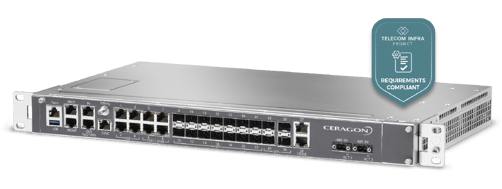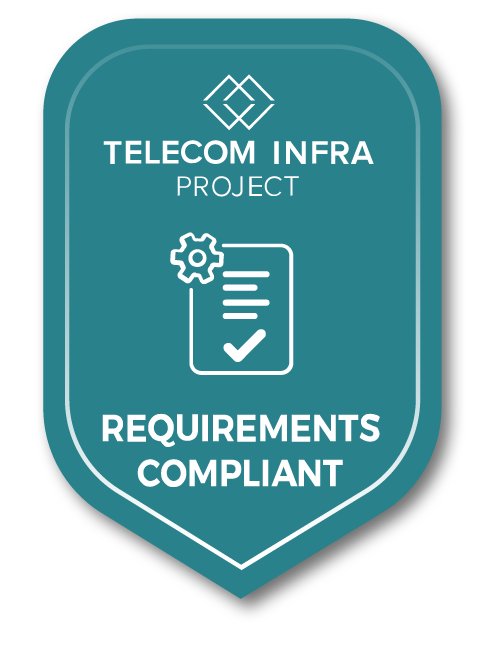×
CONTACT US
CONTACT US
Routers have played a part in mobile networks as early as the transition to 3G and have become more central in 4G. But while IP-based traffic has been an integral part of core and backhaul aggregation sites, many cell sites have continued to rely on layer-2 (L2) switching.
However, 5G use cases can no longer rely solely on L2 switches at the cell site level. Many of 5G’s advanced services, high capacities and low latencies rely on end-to-end layer-3 (L3) routing for more efficient traffic handling and more resilient networks.
For years, cell site routers (CSRs), also known as cell site gateways (CSGs), have been offered as monolithic solutions by a few large vendors. These closed systems combine propriety hardware and software that lock customers into the vendors’ ecosystems. Such solutions have been difficult to scale, and the relative lack of competition have kept costs high and slowed innovation.
With the arrival of 5G, disaggregated cell site gateways (DCSG) have emerged as an attractive alternative to this closed approach.
Disaggregated routing is an open architecture that decouples the hardware and software elements of CSGs/CSRs.
The Open Optical & Packet Transport (OOPT) Project Group of the Telecom Infra Project (TIP) has defined a DCSG as an open white-box cell site gateway device for existing 4G and emerging 5G mobile infrastructures. As a cell site gateway, a DCSG supports L2, L3 and MPLS features with native time synchronization protocols.
Put simply, DSCGs decouple the physical device from the network operating system (NOS) and applications that run on it. Vendors are free to create and innovate using non-proprietary open standards that allow easy interoperability between compliant hardware and software.
Closed CSG vs. Open DCSG
By deploying best-of-breed DCSGs that fit their dynamic needs, operators are reducing their costs and scaling their networks to support the growing demand for 5G-based services. DCSGs enable 5G service providers to avoid vendor lock-in and select among more hardware and software choices for varying deployment scenarios.
DCSGs are growing in importance along with the worldwide expansion and densification of 5G networks, which require more capacity while offering more services. This means operators need to deploy ever more sites, gateways and radios, which, in turn, provides a real incentive for operators to deploy cost-effective white-box DCSG solutions.
According to global research firm Omdia, DCSGs already accounted for around 10% of all new CSGs in 2021, and they are expected to grow rapidly to some 25% of new CSGs in 2024.
DCSGs to Account for 25% of Market in 2024
According to market research firm Dell’Oro Group, disaggregated routers have “become a real thing” in the service provider router market. The market for disaggregated routers grew significantly in 2021, and its ecosystem continued to expand across hardware, software and integration elements. According to another recent report from Dell’Oro, the demand for small cells remains strong, with preliminary findings suggesting that small cell radio access network (RAN) revenues advanced 15 percent year-over-year in the first quarter of 2022.
Network operators are facing several key challenges that drive the market for DCSGs.
The densification of 5G networks and the introduction of multiple new 5G services necessitates that transport networks support network slicing for service orchestration, software-defined networking (SDN) architecture, and dynamic services. As a result, operators must introduce sophisticated routing protocols (such as SRv6, TI-LFA and SR-TE) that are not currently supported by existing CSGs.
With the increase in 5G rollouts, operators need more flexibility than before as they must support a growing number of network architectures and site sizes. Increased competition among growing numbers of DCSG hardware and software vendors reduces the risk of working with smaller vendors, whose offerings can be replaced easily by other open solutions supporting the latest protocols.
The quoted prices of monolithic CSRs usually relate to basic configurations, and often do not include many features and capabilities. In cases when operators need to use additional ports, increase capacity, or support more protocols, they typically need to pay extra fees.
As mentioned above, disaggregated cell site gateways (DCSGs) have emerged as an attractive alternative to closed CSGs/CSRs. Disaggregated routing is an open architecture that decouples the hardware and software elements of previously monolithic CSGs/CSRs.
Main DCSG Components
DCSGs are made up of two main components:
The innovative DCSG approach has been fueled, among other things, by the emergence of carrier-grade Ethernet switching processors by several chip vendors. As a result, multiple vendors are building white-box hardware platforms as a basis for DCSGs with integrated NOS software.
A network operating system is a specialized operating system for network devices such as routers or switches. DCSGs integrate open, best-of-breed NOS solutions that implement advanced networking protocols.
RADIO-AWARE DCSGThe Ceragon IP-50FX is the industry’s first radio-aware DCSG. This solution cost-effectively combines two key functions – an open cell site gateway/router (CSG/CSR) and a radio indoor unit (IDU) – in one white-box hardware device. Now available in the market, the IP-50FX enables service providers to drive down costs and ramp up flexibility in their transport network. The IP-50FX is comprised of three main components:
|
The IP-50FX can be implemented on multiple TIP-compliant DCSG hardware boxes. This gives operators the flexibility to choose the hardware that meets their port-density, site capacity and cost requirements. Ceragon’s cost-effective hardware boxes include a single license for all ports and features, and type C synchronization required by 5G.
Ceragon IP-50FX Open Hardware

Ceragon IP-50FX Hardware Models
The IP-50FX comes equipped with OcNOS, a carrier-grade NOS developed by IP Infusion, a leading provider of network disaggregation solutions. OcNOS is a highly modular and scalable NOS, including containers for third-party applications. Its L3 routing software supports segment routing, which enables efficient network slicing required by 5G networks. OcNOS is integrated with Ceragon’s hardware platform and RAON software to provide a robust integrated solution with radio-aware flow control, timing and synchronization, and centralized management (CLI/SNMP/NETCONF/OpenConfig).
Ceragon’s Radio-Aware Open Networking (RAON) software transforms the IP-50FX into a “2-in-1” DCSG. In essence, RAON enables operators to automatically discover and centrally manage all radios connected to the DCSG through a single IP address, translating into easier configuration and monitoring of an entire radio cluster. RAON informs the cell site router of any changes in connected radios, allowing smart decisions such as traffic rerouting for optimal use of valuable radio resources. An additional important capability is L1 link bonding, which enables efficient combining of multiple interfaces into a single group link. Fully supporting the disaggregated model, RAON can be integrated with any NOS or white-box gateway.
In this use case, a 5G mobile operator has decided to split its all-outdoor unit (AODU) radio architecture from its networking architecture. Deploying AODUs from vendor A, the operator wants to upgrade its existing CSRs using DCSG solutions from vendor B.
The 5G operator needs to add capacity to its radio infrastructure by using new AODUs with higher throughput or by adding new radios in parallel to existing ones. At the same time, the operator needs to upgrade its CSRs to support higher capacity and more high-speed interfaces to handle its new radios.
Operator challenges include:
In this use case, a 5G mobile operator deploying split-mount radios faces the need to add capacity by adding additional AO radio frequency units (RFUs) or millimeter wave (mmW) units. The operator wants to enhance its networking from simple L2 switching to sophisticated segment routing or IP/MPLS routing with new interfaces.
The operator is interested in meeting all its needs from a single wireless vendor that does not specialize in networking, forcing the operator to add additional CSRs to its split-mount sites.
Operator challenges include:
In this use case, a mobile operator is planning to modernize (brownfield) or deploy (greenfield) its CSGs/CSRs as part of 5G rollout plans. Transport is agnostic (either fiber-optic or radio).
DCSG requirements and selection are the responsibility of the network/IP engineering department (and not the microwave backhaul group).
Operator challenges include:
In this use case, a service provider (wireline and/or wireless) plans to modernize or deploy broadband/edge routers as part of its gigabit network infrastructure in support of business/residential customers.
DCSG requirements and selection are the responsibility of the network/IP engineering department (and not the microwave group).
Operator challenges include:

The Telecom Infra Project (TIP) is a global community of companies and organizations working together to accelerate the development and deployment of open, disaggregated, and standards-based technology solutions. As mentioned above, TIP’s Open Optical & Packet Transport (OOPT) Project Group has defined a DCSG as an open white-box cell site gateway device for existing 4G and emerging 5G mobile infrastructures.
Ceragon’s IP-50FX has been awarded TIP’s Requirements Compliant ribbon for hardware and software, and is listed on the TIP Exchange Marketplace.
Combining two vital cell site functions – a cell site router (CSR) and a radio indoor unit (IDU) – into a single cost-effective product, the IP-50FX delivers value-added benefits to network operators and service providers:
The open disaggregated architecture ensures that mobile operators can deploy best-of-breed hardware and software elements to fit their dynamic needs, while evolving their cell sites to support new features and capabilities.
The open IP-50FX solution can be deployed rapidly and smoothly, empowering faster time to market of new technologies and services.
As 5G mobile operators must rapidly densify their transport networks with new sites and links, the IP-50FX breaks the dependency on proprietary and expensive monolithic products, enabling more flexibility and reduced total cost of ownership (TCO).
The virtual indoor unit automatically discovers and provides full visibility of the radio outdoor units (ODUs) via a single point of access and a single IP address.
The IP-50FX has been evaluated and approved by the Telecom Infra Project (TIP), ensuring it meets TIP standards for DCSGs as part of open and disaggregated transport networks.
Several hardware platforms are available to choose from, offering different capacities, port densities and capabilities, while a single license is used to activate all L2/L3 features and ports.
Leveraging its best-in-class NOS that supports new and sophisticated protocols, the IP-50FX provides segment routing to support 5G network slicing, an essential element in providing optimal service for various 5G use cases and applications.
Copyright © Ceragon | Terms & Conditions | Privacy Policy